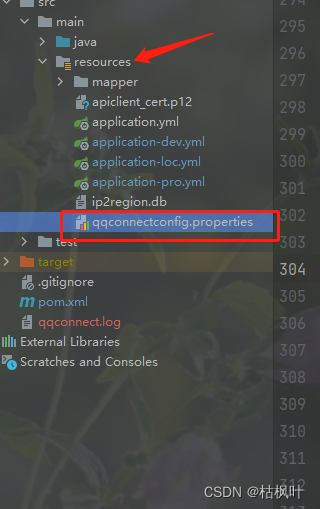第一步:先去qq互联进行创建网站应用:QQ互联 如下图:

第二步:引入qq的jar包,这里采用maven方式引用
<!--QQ坐标-->
<dependency>
<groupId>net.gplatform</groupId>
<artifactId>Sdk4J</artifactId>
<version>2.0</version>
</dependency>
第三步:将资源文件放到如下图目录下面,注意名字(qqconnectconfig.properties)不能改变
qqconnectconfig.properties内容只能改前三行信息:
## qq用户授权信息
app_ID = 移动应用的appid
app_KEY = 移动应用的appkey
redirect_URI = 授权成功后的回调地址
scope = get_user_info,add_topic,add_one_blog,add_album,upload_pic,list_album,add_share,check_page_fans,add_t,add_pic_t,del_t,get_info,get_other_info,get_fanslist,get_idollist,add_idol,del_idol,get_tenpay_addr,get_repost_list
baseURL = https://graph.qq.com/
getUserInfoURL = https://graph.qq.com/user/get_user_info
accessTokenURL = https://graph.qq.com/oauth2.0/token
authorizeURL = https://graph.qq.com/oauth2.0/authorize
getOpenIDURL= https://graph.qq.com/oauth2.0/me
addTopicURL = https://graph.qq.com/shuoshuo/add_topic
addBlogURL = https://graph.qq.com/blog/add_one_blog
addAlbumURL = https://graph.qq.com/photo/add_album
uploadPicURL = https://graph.qq.com/photo/upload_pic
listAlbumURL = https://graph.qq.com/photo/list_album
addShareURL = https://graph.qq.com/share/add_share
checkPageFansURL = https://graph.qq.com/user/check_page_fans
awdTURL = https://graph.qq.com/t/add_t
addPicTURL = https://graph.qq.com/t/add_pic_t
delTURL = https://graph.qq.com/t/del_t
getWeibouserInfouRL = https://graph.qq.com/user/get_info
getweibootherUserInfouRl = https://graph.qq.com/user/get_other_info
getFansListURL = https://graph.qq.com/relation/get_fanslist
getIdolsListURL = https://graph.qq.com/relation/get_idollist
addIdoluRL = https://graph.qq.com/relation/add_idol
delIdolURL = https://graph.qq.com/relation/del_idol
getTenpayAddrURL = https://graph.qq.com/cft_info/get_tenpay_addr
getRepostListURL = https://graph.qq.com/t/get_repost_list
version = 2.0.0.0

第四步:上controller代码
/**
* @description: 获取qq授权链接
* @return:
*/
@Login(false)
@ApiOperation("获取qq授权链接")
@GetMapping("/getQQAuthorizationUrl")
public void getQQAuthorizationUrl(HttpServletRequest request, HttpServletResponse response) {
response.setContentType("text/html;charset=utf-8");
try {
response.sendRedirect(new Oauth().getAuthorizeURL(request));
} catch (QQConnectException | IOException e) {
e.printStackTrace();
logger.error("获取QQ授权链接失败!", e.getMessage());
}
}
第五步:获取授权的qq用户信息
/**
* @description: 拉取qq授权用户信息
* @return:
*/
public ResultVO<QqInfoDto> qqAuthorizateCabllBack(HttpServletRequest request, HttpServletResponse response) throws QQConnectException {
QqInfoDto qqInfoDto = new QqInfoDto();
AccessToken accessTokenObj = (new Oauth()).getAccessTokenByRequest(request);
String accessToken = null, openID = null;
// 用户授权的时候取消了
if (StringUtils.isEmpty(accessTokenObj.getAccessToken())) {
return ResultVO.error("用户取消授权!");
}
accessToken = accessTokenObj.getAccessToken();
// 用户QQ的个人信息
OpenID openIDObj = new OpenID(accessToken);
openID = openIDObj.getUserOpenID(); // onpenId是QQ用户的唯一标示
UserInfo qzoneUserInfo = new UserInfo(accessToken, openID); //TOKEN
UserInfoBean userInfoBean = qzoneUserInfo.getUserInfo();
if(userInfoBean.getRet() < 0){
return ResultVO.error(userInfoBean.getMsg());
}
BeanUtil.copyProperties(userInfoBean, qqInfoDto);
return ResultVO.success("获取成功!", qqInfoDto);
}
QqInfoDto返回实体类
package com.sport.sportcloudmarathonh5.dto;
import com.qq.connect.javabeans.Avatar;
import io.swagger.annotations.ApiModelProperty;
import lombok.Data;
import java.io.Serializable;
/**
* @description: 微信授权用户信息
* @author: zdj
* @date: 2022/11/29 13:55
* @Version:V1.0
**/
@Data
public class QqInfoDto implements Serializable {
@ApiModelProperty(value = "头像集合",hidden = true)
private Avatar avatar = new Avatar("");
@ApiModelProperty(value = "昵称", hidden = true)
private String nickname;
@ApiModelProperty(value = "性别(默认‘男’)",hidden = true)
private String gender;
@ApiModelProperty(value = "vip",hidden = true)
private boolean vip;
@ApiModelProperty(value = "level",hidden = true)
private int level;
@ApiModelProperty(value = "yellowYearVip",hidden = true)
private boolean yellowYearVip;
}
全局返回实体ResultVO
package com.sport.sportcloudmarathonh5.vo;
import java.io.Serializable;
/**
* @author zdj
* @version 1.0
* @date 2021-10-31 19:42:33
*/
public class ResultVO<T> implements Serializable {
private Integer code;
private String message;
private T data;
private static <T> ResultVO<T> getInstance() {
return new ResultVO<T>();
}
public static <T> ResultVO<T> token() {
return response(300, "请登录", null);
}
public static <T> ResultVO<T> success() {
return response(200, "success", null);
}
public static <T> ResultVO<T> success(T data) {
return response(200, "success", data);
}
public static <T> ResultVO<T> success(String message, T data) {
return response(200, message, data);
}
public static <T> ResultVO<T> error() {
return response(500, "服务器异常", null);
}
public static <T> ResultVO<T> error(String message) {
return response(500, message, null);
}
public static <T> ResultVO<T> error(String message, T data) {
return response(500, message, data);
}
public static <T> ResultVO<T> exp() {
return response(500, "服务器异常", null);
}
public static <T> ResultVO<T> response(Integer code, String message, T data) {
ResultVO<T> instance = getInstance();
instance.setCode(code);
instance.setMessage(message);
instance.setData(data);
return instance;
}
public Integer getCode() {
return code;
}
public ResultVO<T> setCode(Integer code) {
this.code = code;
return this;
}
public String getMessage() {
return message;
}
public ResultVO<T> setMessage(String message) {
this.message = message;
return this;
}
public T getData() {
return data;
}
public ResultVO<T> setData(T data) {
this.data = data;
return this;
}
}
注释:qq授权登录java版本目前官方不提供了,所以这里记录下,方便后期使用